Rendering your own lard is super easy and you'll get a significant bump in quality compared to store-bought lard. If you're new to this technique please consider giving it a go!
Refried beans, flour tortillas, tamales...they all have a secret ingredient in common that makes them taste Mexican. What is it?
Be honest, when you hear “lard” what’s the first image that pops in your head?
Traffic jam at the main aorta valve? A pair of treasured jeans that you can no longer button?
Lard gets a pretty bad rap these days. Part of it is misinformation. Part is the fat-shaming culture. And part is the word itself.
Lard.
It sounds….fatty, right?
But the truth is, good lard is healthier than most butters that you regularly cook with. Lard is classified as a monounsaturated fat, so it’s rich in the same fatty acids that the lauded olive oil has.
And while “no one can agree on nothing” when it comes to diet, in general it’s believed that diets higher in saturated fats produce more LDL (the bad cholesterol), and diets high in unsaturated fats produce more HDL (the good cholesterol).
This is why olive oil has become so popular recently. It’s loaded with unsaturated fats. And so is lard.
Maybe it’s just the name. Lard. How about from now on we just refer to lard as white butter?
Either way, lard is an integral part of Mexican cooking, used in tortillas, refried beans, and countless sauces. I hope I can convince a few of you to take a closer look at it!
OK, there are two types of pig fat used to render lard: back fat and leaf fat. Leaf fat produces a lighter, whiter lard that is traditionally used for pastries. Back fat produces a more robust version and is more commonly used for general cooking purposes.
You can usually find both types of fat at your local butcher. You’ll have to ask for it though as they tend to keep it back in the freezer.
Here is what 2 pounds of back fat looks like:
This will produce approximately 2 cups of the cleanest lard you’ll ever use.
The process is simple. We’ll be cooking the fat on low temp, and as the solids produce liquid we’ll strain it off into a holding container.
First, cut up the back fat into evenly sized chunks; about ½ inch works well. There is wiggle room on the size of the chunks, but make sure you are consistent so that the pieces will cook evenly.
Add a couple tablespoons of water to your pan.
This thin layer of water will prevent some initial sticking and it’ll burn off as the fat heats up.
Now add the chopped fat to the pan and cook over medium-low heat.
Nothing will happen for awhile. That’s good!
We want to draw out the liquid fat slowly to prevent burning.
After 15 minutes it’ll look something like this:
You can stir occasionally to prevent any sticking.
At 30 minutes you’ll be somewhere around here:
Now we’re talking! Some of the liquid fat is forming at the base of the pan.
And at 40-45 minutes it will look something like this:
Now it’s time to pull some of the fat out. This prevents any future burning but will also expedite the rest of the process as the solids will have more direct contact with the heat source.
Set up a holding container with a fine-mesh strainer and pour some of the fat through it. I used a stainless steel bowl for this batch.
I also lined the sieve with a cheesecloth to keep out some of the solid bits, but don't sweat it if you don’t have a cheesecloth as the strainer will suffice.
Let the rest of the fat continue to render on the stove.
For this batch I strained liquid fat out four times over 90 minutes.
Eventually the solids will reach a point where they’re not producing any more liquid:
That means they’re done!
Strain off the remainder of the liquid. Here is what I have after all that; about two cups worth:
Let it cool for a bit as it’s no fun spilling piping hot fat when you are jarring it 🙂
In the meantime, congratulate yourself on unknowingly making one of Latin America’s true delicacies: pork chicharones.
The solid bits of compressed fat left over in the pan are the chicharones. Drain them on paper towels, add a little salt, and give ‘em a taste.
Texture will vary depending on how much skin was attached to the back fat, but most likely they will be delicious (at least for some of us). Just be sure to put the brakes on once you start gobbling them down because they are, uhmmm, kinda fatty.
After the liquid has cooled a bit, pour it into your jar of choice.
I typically use a pint-sized Mason jar to hold the lard.
This will turn opaque and solidify in a couple hours, eventually looking like this:
I usually put this in the fridge where it can last for months. If you make a huge batch you can also freeze some of it.
And that’s it! You now have two cups of one of the cleanest cooking fats you’ll ever get your hands on. Congratulations!
One last note on the world of lard...
The lard you find in the baking section of grocery stores has been hydrogenated to increase shelf life so I usually stay away from it. But it's worth asking your local butcher if they sell any house-rendered lard -- sometimes they do as seen in this pic from the freezer of my local meat dude:
This can be a decent middle ground if you're in a bind and need some lard on the fly, but I still recommend that peeps render their own as it's a superior product. Plus it's kinda comforting to know exactly where your cooking fat is coming from 🙂
Okay got your home-rendered lard handy? Now what?!
It'll give you immediate access to these authentic Mexican recipes
And don't forget that you can crisp up your burritos in a teaspoon of lard if you want to turn Pro 🙂
Buen Provecho.
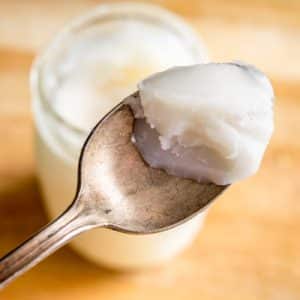
Homemade Lard
Ingredients
- 2 lbs . pork back fat
Instructions
- Chop up the pork back fat into evenly sized chunks, approx. 1/2 inch sized. There is wiggle room on the exact size but try to be consistent so that the pieces will cook evenly.
- Add 2 tablespoons of tap water to a sauce pan, this will prevent some initial sticking and will eventually burn off.
- Add the fat pieces to the saucepan and cook over medium-low heat. It's best to draw the fat out slowly so don't worry if nothing much happens for the first 10-15 minutes.
- Stir occasionally to prevent sticking. When you start to get a pool of fat in the pan, strain some of it off through a fine mesh sieve. Doing this occasionally can expedite the process as it will allow the solid bits to have more direct contact with the pan. Use caution when pouring the hot fat as spills can be dangerous. I typically pour it into a large, stress-free bowl for now. Once cooled you'll be transferring it to your storage container of choice. Wipe off any fat that is dripping down your cooking pan after pouring.
- Continue cooking the fat until it no longer produces any more liquid. That took close to 90 minutes for this batch.
- Strain the final bit of liquid into your holding container and let it cool on the counter.
- The leftover bits of fat are pork chicharones, you can save these for munching if you want to!
- Once cooled you can transfer the lard to your storage container of choice. I typically use a pint-sized Mason jar.
- Store the lard in the fridge where it will keep for months at a time.
Still hungry?!
Want to receive Mexican Please recipes via email when they are posted? Sign up below to subscribe. All recipes are spam free.




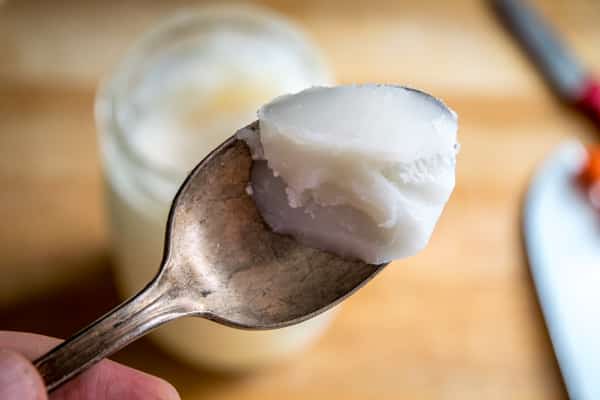
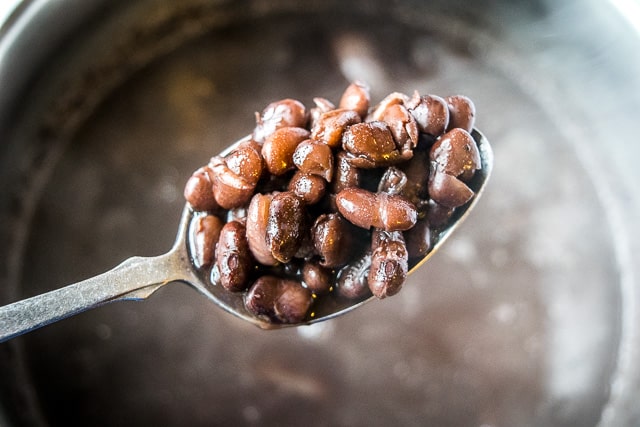






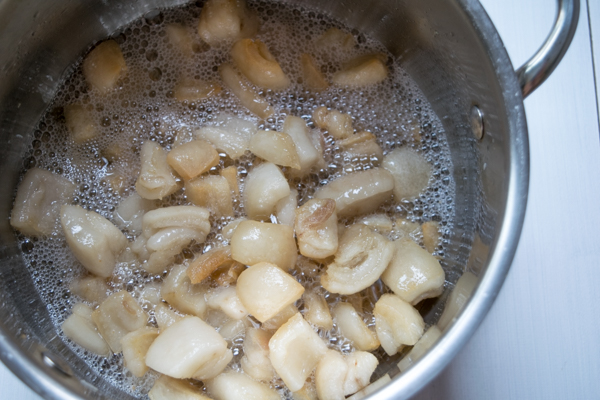
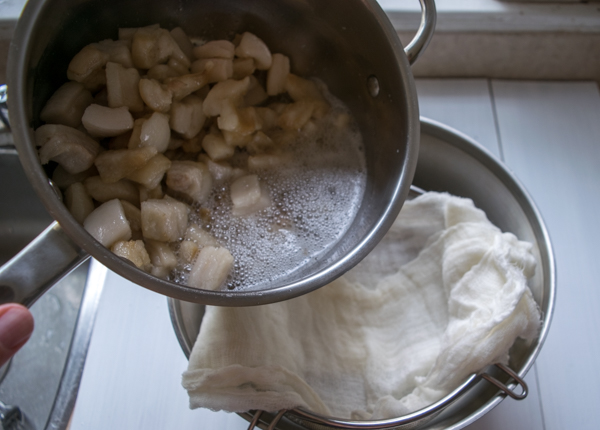






Liz
This is a very encouraging post. I will no longer feel guilty about the pleasures of eating real lard. Yes, this does make the best tortillas, tamales+ pie crust (empanadas)! I'm so glad to have this "recipe", and your helpful suggestions. Agreed, the lard on the grocery shelf is nasty, and a health hazard d/t the hydrogenation + preservatives. Home rendered lard is a wholesome + tasty food in moderation. Dios le bendiga y ¡gracias a Dios por sus alimentos tan Buenos!
Patrick
Thanks much Liz, I'm so glad you found this post! Cheers.
Erin
This post is so great! I love using lard.
My go-to after a rough day at work...
Boil, drain and cut into wedges your favorite potato (make a bunch, you'll want them)
Fry in lard, sprinkle with salt, cumin, smoked paprika
You're welcome 😉
Patrick
Thanks for your note Erin, I'm going to try that! With some chile powder of course 🙂
Erin Neu
Haha, of course! For variety, I sometimes put whole cumin seeds (or mustard or caraway or a mix) right in the fat. And I think I'll stick with lime as my finisher. Chilies are not my friend 😉
Rebecca
Love this !!! We grew up knowing lard is perfect for cooking and baking.
We are always unashamed for using a pure good for you fat😋
Ann Hupe
Thank you! I needed a well-tested recipe for making lard for making tortillas. (Yes, I WILL be using your other recipe for that!) Thank you so very much! Lard DOES contain lots of yummy essential fatty acids for good heart, nerve, brain, and artery/vein maintenance!
Patrick
Thanks much Ann, that will be a great combo 🙂
RAYMOND WEN
Great recipe!
Patrick
Cheers Raymond.
noel
Just what i've been looking for. Always use lard for my beans and other mexican cooking. thanks
Patrick
Thanks Noel, I'm glad this article was helpful for you. Cheers.
Yolanda
Thank God I found you! I’m a Latina but never stayed long enough in the kitchen to learn good kitchen advice. I enjoy your approach in explaining all the details and making delish foods! Thanking you so much! Be safe
Patrick
Thanks Yolanda! I hope you find some keeper recipes on my site 🙂 Cheers.
Xandra
Good clear instructions.
Patrick
Thanks Xandra!
Glen Spencer
Hello Patrick I just figured out my problem I bought pig skin instead of pig fat so I'm attempting to make it with pig skin is that wise thank you
Patrick
Hey Glen! Hmmm there's a chance you have a layer of skin on top of the back fat as I've had that happen before, but if by chance it's all skin you won't be able to use that to render lard. Cheers.
glen warren spencer
Hello Patrick hope you and your family and your friends are doing well in spite of all this I recently purchased 5 pounds a pork skin so if I understand correctly 1 lb of skin will equal one cup of lard I will be doing this Tuesday morning just not sure whether to use a big pot I'll do it all at once or just do a couple of pounds at a time guess I could just do a couple of pounds and freeze the rest of it thank you for putting that recipe out there God's peace
Patrick
Hey Glen! Yeah I think back fat would freeze quite well, but to be honest I would be tempted to just render it all at once -- it keeps so well in the fridge and most likely you would use all of it before any hint of it going bad.
I hope you and your fam are well! Cheers.